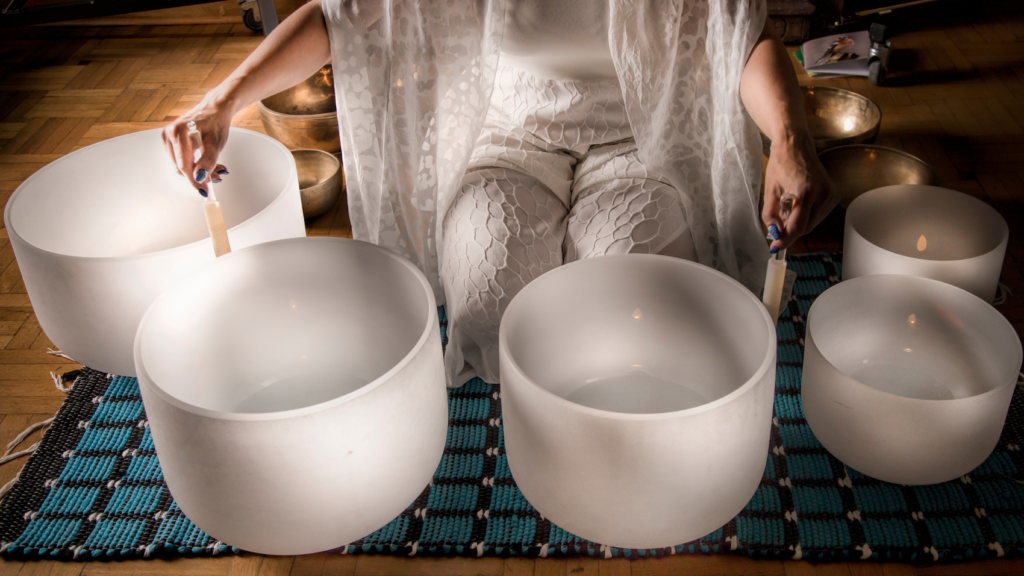Sound Healing



What is it?
Sound healing, also known as sound bathing or sound meditation has gained new traction in recent years as people seek new methods to relieve stress and anxiety. Simply put, sound healing is a practice that uses sound vibrations and frequencies to relax your mind and body.
Similar to yoga, meditation, mindfulness and many other practices, sound healing has gained a lot of popularity recently despite being present in different cultures for centuries. And the concept is intuitive for most of us. For example, white sound for sleeping, soft instrumental music in spas, power beats for workouts, etc. Our affinity to sound is something that comes natural, yet many of us do not know its real power.
These days sound healing can take on many different forms. Music and voice are still very popular, but many practitioners prefer to use instruments like singing bowls, turning forks, gongs and others. That’s because these can work faster to achieve a healing effect. Sound healing is a natural way to synchronize your brain to frequencies that can promote healing throughout your mind and body.
Core philosophy
The basic principle of sound healing is the concept of resonance (the vibratory frequency of an object). The entire universe is in a state of vibration. This includes human beings. Every organ, cell, bone, tissue and liquid of the body, and the electromagnetic fields which surround the body, has a healthy vibratory frequency. If we are not resonating with some part of ourselves or our surroundings, we become dissonant and therefore unhealthy.
From a traditional medical perspective, sound comes through the ear. However, as more scientific evidence has emerged, researchers have found that sound resonates via vibrations in the body. These vibrations can have a multitude of effects on a person.
How it works
Sound healing works in four ways:
Brainwave entrainment
It refers to the capacity of the brain to naturally synchronize its brainwave frequencies with the rhythm of external stimuli. In practical terms, this means that your brainwave frequencies synchronize with the frequencies produced by sound healing instruments. The positive frequencies allow your cells to operate in harmony with each other, healing organs, bones and emotional states.
Frequency following response
Brainwaves have a direct link to mental states of consciousness. There are different types of brainwaves: delta, theta, alpha and beta waves. Relatively slow delta waves happen during sleep, faster theta waves manifest during meditation and beta waves occur when we are problem solving.
Sound waves that correspond to these four types of brain waves are generated when the sound healing practitioner strikes specific bowls. For example, the sound healer can produce vibrations corresponding to the brain’s theta waves to induce the positive healing experienced during meditation.
Balance the brain’s left and right hemispheres
The left and right sides of the brain are very different. The left side of the brain handles logic and problem solving. The right side of the brain handles creativity. Sound healing works on both sides of the brain to develop areas where we might be weak and improve communication between the hemispheres.
Sympathetic resonance
Sympathetic resonance is when the vibrations in one object produce vibrations in another. For example, if you have two tuning forks close to one another, if you strike one, it will cause the other tuning fork to vibrate at a similar frequency. This is the principle that causes the body to vibrate at the same frequency as the sounds produced by crystal bowls, gongs, tuning forks and other sound healing instruments.
Popular modalities
Some popular modalities of sound healing include:
Tuning forks: used to tune other instruments. However, tuning forks can be held to specific parts of the body to send vibrations that release tension and open blocked energy channels.
Gongs: they have stronger vibrations and much richer sounds given their size and structure. Gong baths are excellent for clearing fears or emotional blocks and improving mental clarity.
Singing bowls: they come in different sizes and each one produces a deep sound that heals the mind. Because each bowl produces a unique vibration that works on separate parts of the brain, practitioners use different sized bowls concurrently.
Solfeggio frequencies: this is a form of music that uses sound patterns to stimulate the brain. These tracks help your brain waves achieve a frequency that has benefits. For example, some frequencies can help with fear and change, while others can help awaken one’s intuition, and so on.
Binaural beats: experienced via earphones. This modality is helpful for various purposes, including meditation, lowering stress levels and anxiety, increasing focus, relieving pain, improving sleep and overcoming depression. How does it work? If you listen to a tone of 200 Hz in your left ear and a tone of 205 Hz in your right ear, your brain will perceive an illusory tone and produce a new frequency of 5 Hz (205 – 200 = 5 Hz). This third tone is what we call a binaural beat.
Vocal toning: this type of sound healing involves using one steady tone to balance your cells and open your energetic pathways. The voice is a powerful tool, especially your own voice, because you are self-generating the healing vibrations to shift energetic blocks. That’s why many mantras are so powerful. They are specific tones and words that harness the energetic capacities the ancients knew.
History
The first known use of music as a healing force comes from the Australian Aborigines. They used the didgeridoo as a healing tool for thousands of years. Yogic and Chinese traditions also use certain spoken sounds known as “bija” as part of their chants, mantras and meditations on different body parts. Chanting is particularly powerful in healing. It is thought to create an opiate effect in the body that helps overcome mental and physical pain.
The Greeks also used music to heal. Pythagoras is usually credited as a mathematician; however, he was also known as the Father of Music. He discovered the beauty of harmonic intervals as a mathematical concept. He brought together the idea of sounds creating a pure sensation that could, in his words, create “soul adjustments”. Pythagoras used his harmonies to elicit sleep for his disciples when needed and energy when required through different musical arrangements that were considered to be divine.
Moving forward to recent times, in 1896 American doctors found potential healing effects from sound. They realized this by noting that music could improve blood flow and improve thought processes. Later on, music therapy was used in the 1940s to rehabilitate soldiers returning from WWII.
This eventually led to the concept of sound wave therapy, in the 1950s, developed by British Osteopath Sir Peter Guy Manners. He developed the first machines that produced sound waves for healing. When placed on the body, it matched the vibration to those of healthy cells for that region. More recently, scientists are attempting to codify ancient and modern techniques through studies that look into how sound can heal. This study is in its infancy, however, anecdotal evidence is plentiful and most of us can attest to the benefits of sound.
Benefits and uses
Sound healing can help you clear energetic blockages and thus facilitate healing on a mental and physical level. Some of the benefits of sound therapy include:
- Lower stress levels: by tuning the brain to lower frequencies, sound can help decrease stress quickly and naturally. This can be particularly helpful for whose who are suffering from hypertension and cardiovascular conditions.
- Decreased pain: music can interfere with the moving pain signals, reducing our perceptions of pain. Studies have confirmed that music can help reduce pain.
- Reduced depression and anxiety: sound and music can greatly reduce symptoms of depression and anxiety. When you reduce stress, there is more calmness, less pain and better sleep, all contributing factors that battle depression.
- Enhanced cellular activity: studies have shown that using sound and music therapies can help restore cellular function, improving the function of the membrane walls and biologic activities.
- Optimal DNA repair: research has indicated that specific sound waves can even be used to stimulate DNA to repair itself, especially reprogramming the DNA sequencing. The potential for medical treatments with this is astounding, but research is still in the early stages.
Who practices it
There are multiple avenues through which someone can become a sound healer. Some people attend accredited universities and obtain degrees in music therapy. Others become a sound healer in the way yoga practitioners become instructors – through workshops, training and ultimately, certification.
Typically a sound healing therapist has a training of at least 200 hours, with ongoing updates on the latest techniques. However, there is no governing body that regulates education or training in sound healing. Some associations provide certifications, but there is not a singular body that is the gold standard. There are various online resources like The International Academy of Sound Healing, The American Music Therapy Association or The Sound Healer Association, all of which may be helpful in finding qualified practitioners in your area.
Nonetheless, similar to other practices, we recommend that you find a sound healer through referrals or by asking local practitioners in related areas, such as yoga, meditation or any other practitioner in related fields. Sound healers are becoming very popular nowadays, so most likely you can find many options in your area faster than what you may think.
What to expect
Sound healing sessions can be group or individual sessions. Sound therapy integrates bells, chimes, singing bowls and gongs into a practice, but the options are usually personalized for each session.
In group sessions, you will likely find what people call “sound baths”. Attending a sound bath is a great way to reap the benefits of the practice in a group setting. During a sound bath, you lie down and relax comfortably while you are bathed in healing vibrations of sound. Oftentimes, practitioners provide eye masks or blankets to their clients for further relaxation.
In individual sessions, there is a discussion of what the client needs support with first. Then, the practitioner invites the client to lay down and relax and incorporates breathwork and sound to help move the energy towards balance. The practitioner may include some affirmations during the session as a complement to the sounds.
Regardless of the format of the session, sound therapists are likely to adjust their treatment through feedback, both verbal and nonverbal, focusing the sound on areas of the body that need more help relaxing. Each session can last anywhere from 20 minutes to two hours, or even longer, so it is important you ask in advance so that you can plan your time accordingly.
It is important to note, however, that anyone has access to sound healing on their own. You can do this by humming, chanting, and singing. In fact, if you hum for two minutes you will notice your mood starts to shift. Likewise, there are plenty of tracks and pre-recorded sessions available online that you can use on-demand. While not nearly as targeted as sound healing sessions, these are resources you can access on your own accord.
Interesting facts
Here are some interesting facts about the nature and power of sound.
- We are all a chord. Matter is vibrating energy; therefore, we are a collection of vibrations of many kinds. As a result we can think of ourselves as a complex chord.
- Health is having the chord in complete harmony. The WHO defines health as a “state of complete physical, mental and social well-being”. It follows that a way to look at health is maintaining the frequencies or our different dimensions in total harmony.
- Noise harms and even kills. The WHO says: “traffic noise alone is harming the health of almost every third person in the WHO European Region. One in five Europeans is regularly exposed to sound levels at night that could significantly damage health.”
- We used to be naturally balanced. Back in paleo times, our nervous systems calibrated themselves to the natural outdoor sounds: wind sounds, rain sounds, twig-snaps, people.
- Sound healing in everyday life. You can experience the dynamics of sound healings in other places other than a sound healing session. Some experiences involve the sonic properties of the space itself, such as reverberation patterns in a churn or cathedral. This is a type of a social sound bath.
Closing statement
Throughout the ages, sound has traditionally been a fundamental component of healing practices, oftentimes playing a central role. Sound therapy is an important addition in our wellness journey because of its power to increase energy flow, balance the brain and create calmer emotional states.
Everything in the universe vibrates at its own individual frequency and so do our bodies. Sound healing can bring back harmony at times when the only thing we feel is noise. It has virtually no downside, it is natural and it has a legion of followers, many of whom swear by the many benefits sound healing brought for them.
Newsletter
Sign up for emails to get the scoop on our latest articles, new developments and more.
